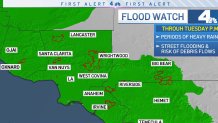Several burn areas are included in a flash flood watch in effect Monday and Tuesday for parts of Southern California as a strong winter storm moves through the already soaked region.
The heaviest rainfall from the storm is expected Monday afternoon and evening. The wet weather follows last week's powerful winter storm that flooded some SoCal streets and freeways.
This week's storm is expected to bring higher rainfall totals, but even modest rainfall on hillsides left bare by a brush fire can trigger damaging and potentially deadly slides.

Get top local stories in Southern California delivered to you every morning. >Sign up for NBC LA's News Headlines newsletter.
Rain and Wildfire Burn Areas
When fire moves through a watershed, it creates waxy seals that don't allow water to penetrate soil. Instead, the rainwater runs off the soil surface causing debris flows.
The fast-moving slides usually start on steep hills and accelerate as they move downslope. The higher the degree of slope, the faster the water and debris will move, sometimes with enough force to move boulders, tear out trees and damage buildings and bridges.
Local
Get Los Angeles's latest local news on crime, entertainment, weather, schools, COVID, cost of living and more. Here's your go-to source for today's LA news.
The first storms that strike a burn area are the most critical. Hillsides burned by recent wildfires have the threat of mud flow and erosion issues as a parade of winter storms moves through Southern California.
Start thinking ahead to prepare. The USGS maintains a burn zone hazards map here.
What to Inspect
Look around your home and property for landslide warning signs.
- Cracks or bumps appear on hill slopes, ground or roads
- Water or saturated ground in areas not normally wet
- Evidence of slow, downhill movement of rock and soil
- Tilted trees, poles, decks, patios, fences or walls
- Doors and windows stick or cracks appear on walls, etc.
Be Aware During Mud and Debris Flows
- Listen for trees cracking, rocks banging together or water flowing rapidly (especially if near a stream or river)—debris flow may be close by.
- Move it! Whether you are in a vehicle, outside or in your home—get to safer ground.
- Be small. If there is no way to escape, curl into a tight ball and protect your head the best you can.
After the Storm
- Flooding: Usually occurs after landslides or debris flow
- Damaged area: Roadways and bridges may be buried, washed out or weakened—and water, gas and sewer lines may be broken
- Downed power lines: Report them to power company
- Inspect: Look for damage around home and property and watch for new landslide warning signs:
- Check foundation, chimney, garage and other structures.
- Report any broken utility lines or damaged roads to local authorities.
- Watch for tilted trees, poles, decks, patios, fences or walls.
- Notice doors or windows stick, cracks appear, etc.
Sam DiGiovanna is a 35-year fire service veteran. He started with the Los Angeles County Fire Department, served as Fire Chief at the Monrovia Fire Department and currently serves as Chief at the Verdugo Fire Academy in Glendale.



